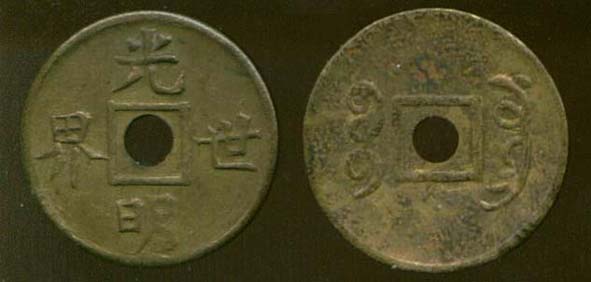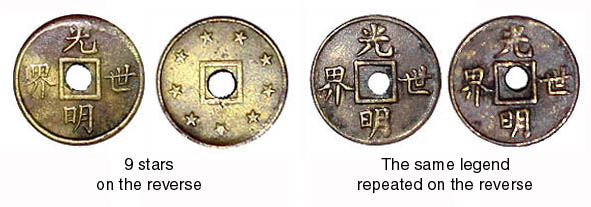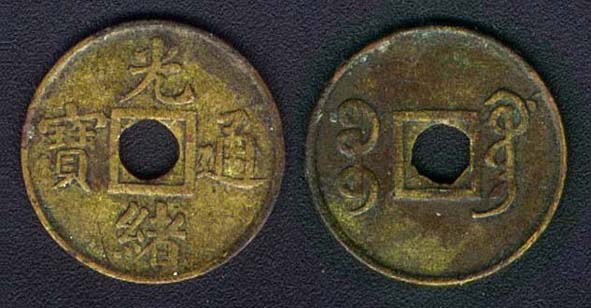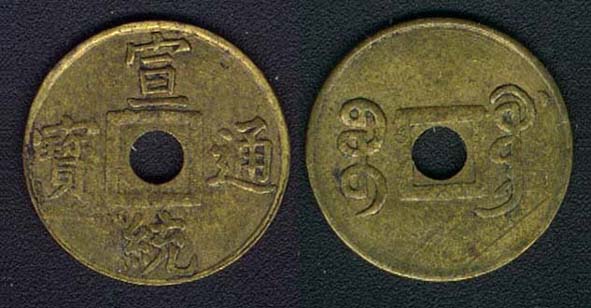| Obverse and Reverse | Description |
 |
No. 334 |
| Diam.? mm | |
| Wt. ? g. | |
| Rareness C | |
| Mint Evolution and Peculiarity | |
|
Information provided by ®³¬P¤½Àï from the book : Counterfeits and Copies of Kwangtung Coins by Robert D.Thompson Published and Printed by the Government Printer on behalf of the City Museum and Art Gallery Urban Council, Hong Kong Nov,1971 Lastly, one sometimes finds odd coins which are well made and seem to be old (as indeed they are) one will find, FOR EXAMPLE : A cash coin of Tao Kuang, which a Chinese character mint mark above and the right of the hole and a Manchu mint mark to the left and below the hole. Thus the Chinese mint character appears twice on the reverse and the Manchu mint character twice on the reverse. This type of cash coins are always part of a set for all the mint marks of China. Even if found as odd ones they privately made for use in games. One peculiar should also be mentioned. It is a brass piece struck at the Canton Mint during the reigns of "Kuang Hsu" and "Hsuan Tung" with four Chinese characters "Kuang Ming Shih Chieh". (The world of brightness, euphemism for "The world of the deaths") on the obverse, and a Manchu mint-mark "Kwang" on the reverse. It is of the same size as Kuang Hsu one wen and was probably made to the private orders of the officials in charge of the mint for use as "Ghost Money", which, according to the Chinese traditions, is to be thrown into the street in vast numbers as gift to the ghosts at the time of the Hungry Ghost Festival on the 14th day of the 7th moon. Thanks indeed to ®³¬P¤½Àï, for the valuable information. YKL | |
| Obverse and Reverse | Description |
 |
No. 335 |
| Diam.? mm | |
| Wt. ? g. | |
| Rareness C | |
| Mint Evolution and Peculiarity | |
|
Information provided by Dongjin of Fukchow, Fukien Province.
These coins were the first struck coin (Trial minting coin not for general circulation) minted by the Canton Mint. As I know that these coins were minted in 3 diffrent forms: The first one is four Chinese characters "Kuang Ming Shih Chieh" on the obverse and two Manchu characters meaning (Kwang Mint) on either side of the hole on the reverse. The second one is four Chinese characters "Kuang Ming Shih Chieh" on the obverse, and 9 stars on the reverse. The third one is inscribed with the same legend "Kuang Ming Shih Chieh" on the both sides. Can you contact the owner of the above coin for me? Thank you very much! Fukchow Dongjin Thanks indeed to Dongjin, for the valuable information. YKL | |
| Obverse and Reverse | Description |
 |
No. 336 |
| Diam.16.5mm | |
| Wt. 1.4g. | |
| Rareness E | |
| Mint Evolution and Peculiarity | |
| This brass circular small coin was struck by machinery with a round hole in the centre, four Chinese characters (Kuang Hsu Current Coin) on the obverse; two Manchu Characters meaning (Kwang Mint) on either side of the hole on the reverse. It was first minted at the Kwangtung Mint in 1906.
| |
| Obverse and Reverse | Description |
 |
No. 337 |
| Diam.17mm | |
| Wt. 1.4g. | |
| Rareness D | |
| Mint Evolution and Peculiarity | |
| This brass circular small coin was struck by machinery with a round hole in the centre, four Chinese characters (Hsuan T'ung Current Coin) on the obverse; two Manchu Characters meaning (Kwang Mint) on either side of the hole on the reverse. It was first minted at the Kwangtung Mint in 1910.
| |